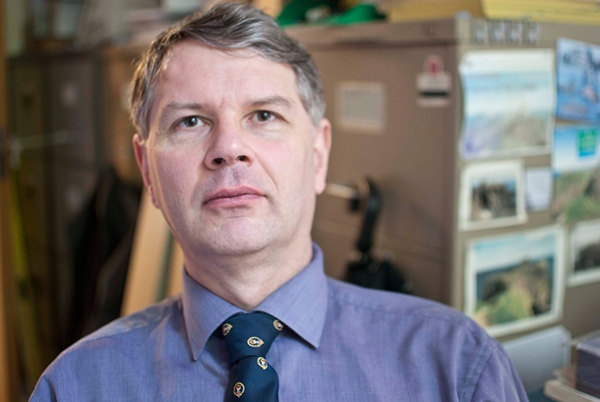Dr Burt's research activities can be divided into four main categories: biometeorology and bioclimatology, with emphasis on insect aerobiology and palaeoenvironments; pollen and spore aerobiology; investigations of the atmospheric dispersal of pollutants, and general meteorology/climatology.
Biometeorology, with emphasis on insect aerobiology
Initial, novel, investigations demonstrated that small temporal (few minutes) and spatial (metres to tens of metres) thermal convective structures in the atmosphere are important in the concentration and dispersal of small insects, especially those such as aphids and thrips which feed on cereal crops. Conventional monitoring equipment does not normally operate at these resolutions, hence the impact of such structures in creating non-randomness in the arrival of airborne insects, and in epidemiological studies, may have been underestimated. This was verified for other species in field investigations overseas.
Many insect pests fly at night. Studies of the role played by nocturnal wind systems in dispersing and concentrating such insects drew together material on this subject for the first time, as an aid to insect forecasters and pest controllers identifying likely areas of pest insect outbreaks.
On larger spatial and temporal scales, Desert Locusts have the capacity to migrate across the Atlantic Ocean, a feature of their behaviour which takes them outside their normal ecological ranges and which is not predicted through laboratory investigations of flight capacity. Historically, however, such migrations are rare, and future movements are unlikely to become of economic importance, even under proposed climate change scenarios. Such migrations suggest that the arrival of Old World species may have affected the speciation of New World grasshopper species. The results of this work also demonstrated the problems of transferring laboratory results directly in to the field (which have informed other aerobiological and ecological studies).
Development of a predictive model relating cloud-top temperature to rainfall in the Sahelian region of Mali, and the use of satellite remote sensing to monitor it, has enabled local plant protection teams to target their pest control activities more efficiently and economically over the vast areas where the pest grasshopper Oedaleus senegalensis is endemic, thereby reducing the impact of crop losses on the livelihoods of subsistence farmers in the area.
The discovery of the degradation of the ozone layer over Antarctica, and its subsequent impact on the health and well-being of animals (including man) in the southern areas of South America in the 1980s, led to a major initiative to develop accurate ultra-violet (UV) radiation forecasting tools. Such forecasts have enabled people to be made aware of the times of higher UV radiation levels, thereby reducing human and livestock exposure to physiologically-damaging levels of radiation.
Pollen and spore aerobiology
Mycosphaerella fijiensis is the fungal spore causing Black Sigatoka disease in banana and plantain. The disease is of major economic importance to subsistence farmers in developing countries, causing significant reductions in fruit quality and yield. The results of five years of research in Central America and Africa on aspects of the airborne dispersal and epidemiology of this pathogen resolved a number of previously unclear aspects of its behaviour. Although spreading worldwide, the results from this investigation showed that the reasons for the disease not becoming well-established and destroying the subsistence-based banana industries of the Caribbean is that periods of exposure to sunlight (as normally experienced by windborne spread of spores from diseased plantations in the Americas) kills the spores before they reach potential host plants, and also that proportionally low numbers of spores enter the atmosphere from infected plants. Consequently, continued adoption of plant quarantine and disease control methods in the Caribbean should prevent the spread of this disease. Current investigations of long-distance dispersal of pollen and spores, and also the impacts of climate change on dispersal patterns, have evolved from this work, and also link to the airborne pollution studies outlined below.
General meteorology and climatology
Investigations of the atmospheric dispersal of pollutants
In recent years Dr Burt has been involved in a series of investigations which have started to address the complexities of topographic airflow and the potential for pollution transport in the southeast of England, at regional and transboundary levels. No previous investigations of the relationship between airflow and topography, and the influence of these on the dispersal of pollution, have been undertaken in this region. Preliminary results have shown the complexity of the airflows in the region, the relationship between local and synoptic scale flows and why existing physical models of pollution dispersal (relating to dispersal within the lowest 1500 m of the troposphere) were not reflecting reality. A greater emphasis should be placed on integrating measured data from monitoring stations, in association with field observations.
Climate and climate change impacts on organisms
Understanding and predicting future climate change impacts is enhanced through identifying such changes in the past and considering their likely occurrence in the future. The sunken forests of the Thames Estuary and south Cornish coast provide a wealth of data on palaeoenvironments, and preliminary studies are investigating how these evolved and the impact of environmental change (including climate change) upon them.






